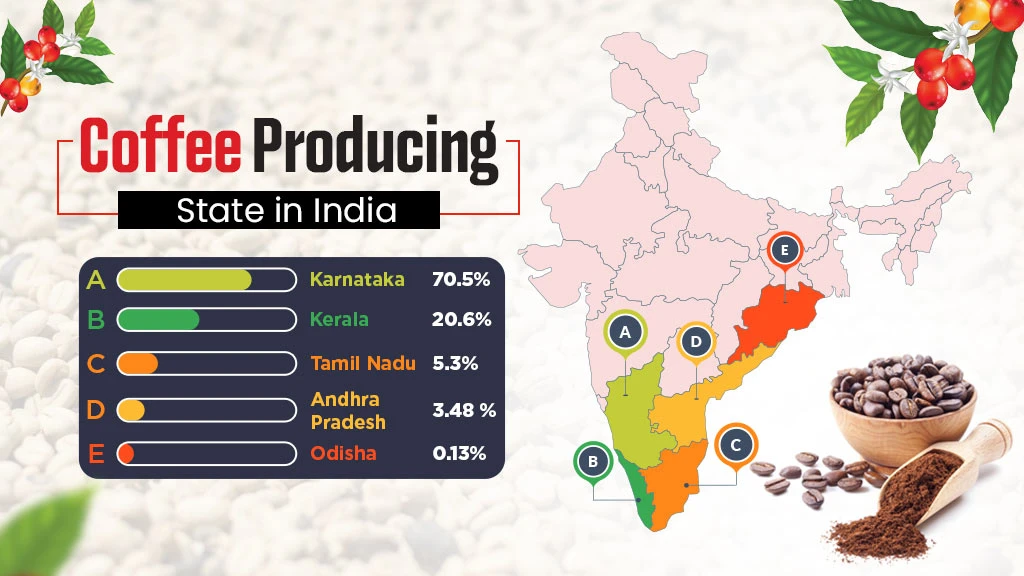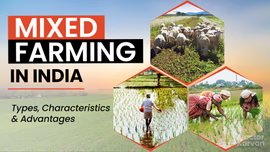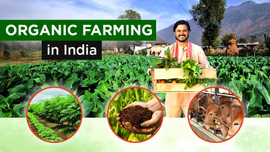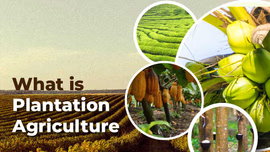Coffee Production in India - Growing Conditions, Types and Top Coffee Producing States

India is rich in its geographical diversity and microclimates. For this reason, India’s coffee production landscape has been able to thrive. In this explore we will explore coffee production in India, along with its farming practices, major production states and different varieties found.
Table of Contents
- Coffee Plantation in India
- What are the Popular Coffee Varieties Found in India?
- Farming Techniques for Coffee Cultivation in India
- What are the Major Coffee Producing States in India?
- Conclusion - Future of Coffee Plantation in India
Coffee Plantation in India
Commercial coffee plantation in India began in the 18th century during British rule. However, history of coffee production can be traced back to 1600 AD. It is said that a legendary saint named Babu Budan smuggled "seven seeds" of “mocha” from Yemen and planted them in the Chandragiri hills of Karnataka. This became the legacy that helped shape India’s thriving coffee culture.
Today, India is the world's seventh largest producer of coffee, with 3.7 lakh tonnes of global coffee production. The country is also one of the most important coffee export hub globally, with more than 9,300 tonnes of coffee exported to countries all over the world in 2025. Coffee is also considered an important cash crop in India that helps provides direct employment to 2 million people and contributes majorly to social and economic development.
What are the Popular Coffee Varieties Found in India?
India produces two varieties of coffee, namely Arabica and Robusta.
|
Varieties |
Robusta Coffee |
Arabica Coffee |
|
Botanical name |
Coffee Canephora |
Coffee Arabica |
|
Preferred Growing Regions |
Low to mid elevations, warmer humid climate. |
Higher elevations, cooler climates. |
|
Indian Regions |
Karnataka, Kerala, parts of Tamil Nadu. |
Karnataka, Tamil Nadu, Andhra Pradesh, Odisha, NE |
|
Shape and size |
Small rounder |
Larger, oval shaped with a curved crease. |
|
Flavor profile |
Strong, bold, earthy, bitter. |
Smooth, mild, aromatic; fruit and floral |
|
Disease and Pest Resistance |
High |
Low |
The government of India has given Geographical Indication (GI) to 5 varieties of Indian coffee, which are:
- Coorg Arabica coffee
- Wayanaad Robusta coffee
- Chikmagalur Arabica coffee
- Araku Valley Arabica coffee
- Bababudangiris Arabica coffee
Farming Techniques for Coffee Cultivation in India
Coffee plantation is an important crop for plantation agriculture in India. The climatic conditions for coffee in India vary depending on the variety of coffee cultivated. The requirements for growing the best coffee beans in India are as follows:
|
Soil Requirement |
Rich loamy soil with plenty of organic matter and good drainage is ideal for coffee growth. The ideal pH range is between 5.5 and 6.5, which is slightly acidic. |
|
Temperature |
The temperature range for coffee cultivation should be from 15° to 28° C. It is usually grown in areas that receive between 1500 and 2500 mm of rainfall. |
|
Altitude |
Arabica grows best at higher altitudes of 1000-1500 m with shade, while Robusta requires lower elevation of 500-1000 m. |
|
Irrigation |
Crops can be irrigated during the monsoon season, but during dry periods, additional irrigation is needed. |
|
Nutrient Management |
Maintain soil fertility with compost, manure and periodic liming in soil to keep pH optimal for plant nutrition. |
What are the Major Coffee Producing States in India?

Some of the major coffee producing states in India are Karnataka, Kerala, Tamil Nadu, Andhra Pradesh, Odisha and many Northeastern States. In the section below we have elaborated more:
Karnataka
Karnataka is India's leading coffee producer in the country, contributing over 70% of the national output (about 2,48,000 MT tonnes) between 2022-2023. The state grows both types of coffee: Arabica and Robusta. Chikkamagaluru, Kodagu (Coorg), and Hassan are some of the state's highest coffee-growing regions. Each of these region's coffee is known for its own unique flavour and high-quality beans. Some of the Arabica cultivars grown in Karnataka are S.795, Cauvery, and Selection 9.
Kerala
Kerala holds the second position as the highest coffee producing states in India, contributing approximately 23% of nations coffee production. Between 2022-2023, Kerala produced approximately 70,450 MT of coffee, with Robusta Coffee accounting for the majority of the produce. Coffee cultivation in Kerala is able to thrive due to the hot, humid weather and fertile soil conditions. The major coffee growing regions in Kerala include Wayanad, Idukki, Palakkad and Travancore. The Wayanad district is especially famous for its high-quality Robusta beans, which are popular for their full-bodied flavor and low level of acidity. Kerala’s coffee estates are characterized by shade grown practices and intercropping with spices like pepper, ginger and other medicinal herbs contributing to the unique flavor profile of the beans. Popular varieties grown in the state include S.274, CxR and Peridenia.
Tamil Nadu
Tamil Nadu is known for its high-altitude Arabica coffee and holds the third position in coffee producing states in India. The state contributes around 5% to the country’s total coffee production, reaching approximately 18,700 MT between the year 2022-2023. The major coffee growing regions in the state include Pulney Hills, Nilgiri, Salem and Coimbator. Pulney hills lead in production, with over 7,830 MT produced annually. The high elevation, cold weather and fertile soil of this region result in coffee with strong acidity and fruity flavors. The Shevaroy Hills in the state also cultivate notable shade-grown Arabica coffee, which is famous for its delicate flavors. Popular varieties grown in the state include Arabica - S.795, K ents, Cauvery Robusta and Peridenia.
Andhra Pradesh
Due to its rapid expansion in coffee cultivation over the last few decades, Andhra Pradesh has risen to the fourth position among India's largest coffee producers. The annual coffee production output of the state was 12,265 MT between the years 2022-2023. The state is recognized for producing high-quality Arabica beans produced in its hilly, tribal dominated regions. Coffee production is concentrated to the regions of easter ghats – notably the Araku Valley and agency areas of Chintapalli, Paderu, Maredumilli in Vishakhapatnam and east Godavari districts. These rain fed, high altitude regions support organic and shade grown cultivation. Popular varieties grown in the state include S.795, S.5A, S.9, Selection 4, Selection 5, Cauvery. The coffee that comes from this region is famous for its rich flavor and chocolatey notes.
Odisha
Odisha, though a non-traditional coffee growing state, has emerged in recent years as a promising region for coffee cultivation. The production is mostly centred on Arabica coffee, with around 465 MT of production in the year 2022-2023. Coffee farming in in Odisha is primarily tribal-driven and organically grown, often intercropped with spices and fruits for a unique flavor profile. Koraput district in Odisha, along with emerging cultivation areas like Rayagada, Gajapati, Kalahandi, Kandhamal and Koenjhar, offer ideal high-altitude conditions for growing Arabica coffee varieties. Popular varieties include Chandragiri, Cauvery, and Ruiru 11. The coffee has a rich taste and aroma with mild acidity. In order to promote coffee production and cultivation in the country, the government has also introduced the new coffee mission scheme, with a plan to expand cultivation and increase production to over 20,000 MT by 2030.
Northeast States
The Northeastern Regions (NER) of India, which are traditionally known for their tea, are gaining prominence these day for coffee production and cultivation. These states account for 1% of India's total coffee output, or 125 MT annually, across its seven states. Coffee production here is marked by small scale cultivation, organic practices, and tribal-community work. For example, the Cachar district in Assam is an important coffee-cultivation region. The coffee produced here is characterized by earthy and spicy undertones, with a medium body. Other important regions in northeast include, Mon, Mokokchung (Nagaland), Gomati (Tripura), Ukhrul, Senapati (Manipur). North easter coffee are gaining popularity in domestic and international markets for their quality, organic credentials and unique cup profiles.
Conclusion - Future of Coffee Plantation in India
India is the third largest producer and exporter of coffee in Asia. Globally, India is the 7th largest producer and 8th largest exporter of coffee. In 2023, India's coffee market size was estimated to be 1.81 billion US dollars, as per Stellar Market Research.
At present, coffee plantations in India are limited to the Western and Eastern Ghats states, such as Karnataka, Kerala, and Tamil Nadu. These three states together account for 96% of the country's total coffee production. Further, 70% of the coffee produced in the country is exported, and only 30% is consumed domestically.
With the increased demand for coffee and its growing popularity among youths, the coffee market size is expected to increase to 2.43 billion US dollars by 2030, according to Stellar Market Research. Further, the Coffee Board of India has emphasized organic coffee production to meet the demand for chemical-free coffee beans.
Thus, there is a vast scope for coffee plantations in India, and the Indian government must take steps to increase coffee production by enabling its spread in the Northeast region.
Frequently Asked Questions On Coffee Production in India
1. Which state has the highest coffee production in India?
Karnataka is the largest producer of coffee in India, with a share of 70%.
2. What is India's rank in coffee production?
India is the seventh largest producer of coffee in the world.
3. Which is the coffee capital of India?
Coorg, officially known as Kogadu, is the coffee capital of India.
4. Which soil is found suitable for growing coffee in India?
Laterite soil is found suitable for growing coffee in India.
5. How many types of coffee are produced in India?
In India, two varieties of coffee are produced: Arabica and Robusta.
6. Which state is known as the coffee bowl of India?
Karnataka is known as the coffee bowl of India.
7. Who invented Coffee in India?
Baba Budan is associated with bringing seven beans of coffee from Yemen and planting them in the Chandragiri hills of Karnataka.


Related Blogs












